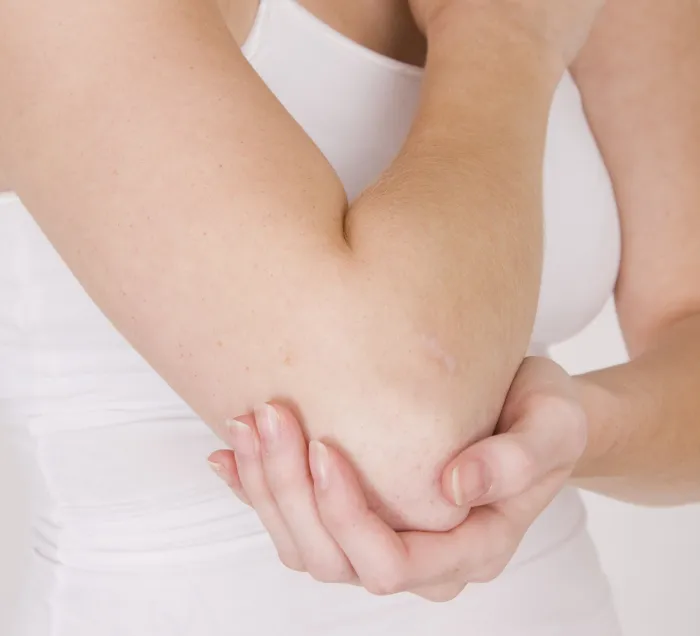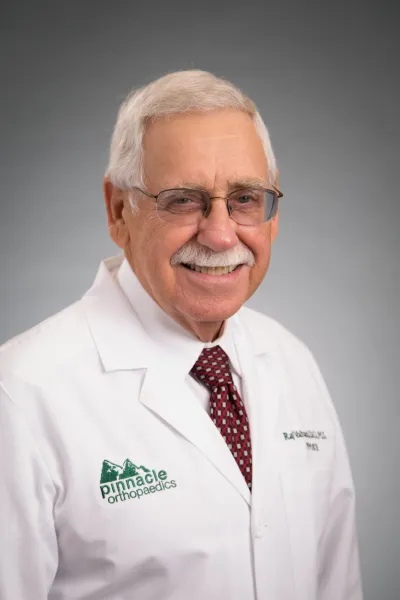
Elbow

Elbow injuries are surprisingly common, affecting athletes, manual workers, and even those with less physically demanding lifestyles. Whether you're experiencing nagging pain, sudden sharp discomfort, or reduced range of motion, understanding elbow injuries is the first step toward recovery.
Pinnacle Orthopaedics is here to help you navigate the causes, symptoms, diagnosis, and treatment of elbow injuries.
Our team of expert orthopedic specialists is committed to helping you throughout your journey—from diagnosis and treatment planning to rehabilitation and recovery. You can visit our doctors in one of our convenient locations below:
Elbow doctor in Marietta
Elbow doctor in Hiram
Elbow doctor in Woodstock
Elbow doctor in Canton
Read below to learn more about the different types of elbow injuries and their causes.
The anatomy of the elbow
The elbow is the hinge joint in the middle of the arm. This allows the hand to be moved and stretched from the body to reach or grasp. The elbow is a joint with flexor muscles and ligaments that control arm flexion and rotation.
As a hinge joint, the elbow has limited movement and only allows for flexing and extending the forearm and rotating the forearm and wrist. The range of motion of the elbow is limited by the olecranon of the ulna. The elbow extends only 180 degrees.
Many ligaments surround the elbow's joint capsule and help the joint maintain its stability. The radial and ulnar ligaments connect and keep the position of the radius and ulna bones. The annular ligament extends from the ulna around the head of the radius to hold the forearm bones together. These ligaments control movement and stretching of the elbow.
Three bones form the elbow joint: Humerous (upper arm) and the paired radius and ulna (forearm.)
Common elbow injuries and conditions
The elbow can be affected by several injuries and conditions. These range from overuse injuries that develop gradually to sudden fractures or dislocations. Understanding these elbow problems is the first step to finding relief and restoring function.
Tennis elbow or lateral epicondylitis
Tennis elbow is an overuse injury resulting from the inflammation of the tendons that attach to the outer bony bump of your elbow. Pain radiates during activities involving gripping and wrist extension, affecting people of all activity levels.
Treatment for tennis elbow starts with RICE therapy and over-the-counter pain relievers. Physical therapy is also crucial for strengthening and improving mobility.
Golfer's elbow or medial epicondylitis
Similar to tennis elbow, golfer's elbow involves inflammation of the tendons on the inner elbow. Pain is experienced during activities requiring wrist flexion or clenching motions.
Treatment mirrors that of tennis elbow, emphasizing rest, pain management, physical therapy, and, infrequently, injections or other procedures.
Olecranon bursitis
The olecranon bursa, a fluid-filled sac at the pointed tip of your elbow, can become inflamed. This causes pain, swelling, and sometimes redness at the back of the elbow. It often occurs after a direct blow or from leaning on the elbow for prolonged periods.
Olecranon bursitis is often managed with rest, ice, compression, and anti-inflammatory medication. Draining the bursa (aspiration) may be necessary for excess swelling, whereas corticosteroid injections help reduce severe inflammation.
Elbow fractures
The bones making up your elbow joint are susceptible to fractures. These injuries often result from falls or direct impact, causing severe pain, swelling, deformity, and inability to move the joint.
Treatment depends on severity. Simple fractures may require a cast or splint for immobilization or closed reduction to realign the bone manually.
On the other hand, complex fractures often necessitate surgery using pins, wires, or plates to secure the bone during healing.
Elbow dislocation
This occurs when the elbow bones are forcefully displaced from their normal positions. Dislocations are often caused by falls and are accompanied by significant pain, deformity, and immobility.
Emergency treatment involves closed reduction, where a doctor realigns the joint. Immobilization follows to allow healing. Complex dislocations or unsuccessful reductions may require surgery.
Arthritis
Elbow arthritis refers to inflammation and degeneration of the joint surfaces within the elbow. Some of the most common types of arthritis that affect the elbow include:
Osteoarthritis: The most common type, osteoarthritis results from wear-and-tear of the cartilage covering the ends of the bones within the elbow joint.
Rheumatoid arthritis: An autoimmune condition where the body's immune system mistakenly attacks the lining of the joints (synovium), causing inflammation, pain, and cartilage breakdown. Rheumatoid arthritis often affects multiple joints, including both elbows.
Post-traumatic arthritis: This develops after a significant elbow injury, such as a fracture or dislocation. Even with proper healing, the initial injury can increase the risk of arthritis later on.
Ligament sprains and tears
The ligaments around the elbow, such as the ulnar collateral ligament (UCL), provide stability. Overstretching or sudden force can lead to sprains (stretching) or tears of these ligaments, causing pain and instability, particularly in athletes who perform throwing motions.
The RICE protocol, pain medication, and immobilization are the first steps. Physical therapy plays a major role in strengthening and stabilizing the joint.
However, severe ligament tears, particularly in athletes, may need surgery to restore optimal elbow stability.
Signs and symptoms of an elbow injury
The signs and symptoms of elbow injuries and conditions can vary depending on the specific issue, but here's a breakdown of the most common ones:
Pain on the elbow that may radiate down the forearm or towards the shoulder.
Swelling, warmth, and redness.
Stiffness and limited range of motion
Weakness
Numbness or tingling
Other symptoms may include clicking or popping sound, bruising, and deformity.
Symptom severity does not always tell you the seriousness of the condition. Some major injuries might have mild pain at first.
So, it's crucial to consult an orthopedic specialist at Pinnacle Orthopaedics for any persistent symptoms that limit your daily activities for proper diagnosis and treatment.
At Pinnacle Orthopaedics, our team of board-certified orthopedic doctors has extensive knowledge about diagnosing and treating the full spectrum of elbow problems.
We utilize a comprehensive approach, including thorough physical exams and advanced imaging like X-rays, MRI, and CT scans, to pinpoint the exact source of your pain.
Common causes of elbow problems
Elbow problems can stem from various causes. Here's a breakdown of the most common culprits:
Overuse injuries
Repetitive motions that strain the tendons and muscles around the elbow are a major cause of conditions like tennis elbow and golfer's elbow. Some examples of these activities include:
Sports (tennis, golf, throwing)
Manual labor (construction, plumbing)
Extended time using a computer and mouse
Sudden injuries
Falls, car accidents, or direct blows to the elbow can cause fractures, dislocations, ligament sprains, and even nerve damage. These injuries often cause immediate pain, swelling, and limited mobility.
Improper technique
Using incorrect form or technique during sports, exercise, or work activities puts excessive stress on the elbow joint. This can increase your risk of both acute injuries and gradual wear-and-tear conditions.
Underlying medical conditions
Arthritis (both osteoarthritis and rheumatoid arthritis) can damage the cartilage and joint tissues of the elbow, leading to pain, stiffness, and inflammation. Other conditions like gout, infections, and nerve disorders can affect elbow function.
Age
With age, our tendons and ligaments naturally weaken, becoming more prone to injury and degeneration. The cartilage in our joints also changes, making conditions like osteoarthritis more likely.
Get the best diagnosis and treatment at Pinnacle Orthopaedics
Elbow injuries can sideline you from the activities you love and make even simple tasks a challenge. That's why it's important to get expert care and the most effective solutions at the best orthopedic sports medicine near me.
At Pinnacle Orthopaedics, we understand the frustrations of elbow pain and are dedicated to helping you regain function and quality of life.









